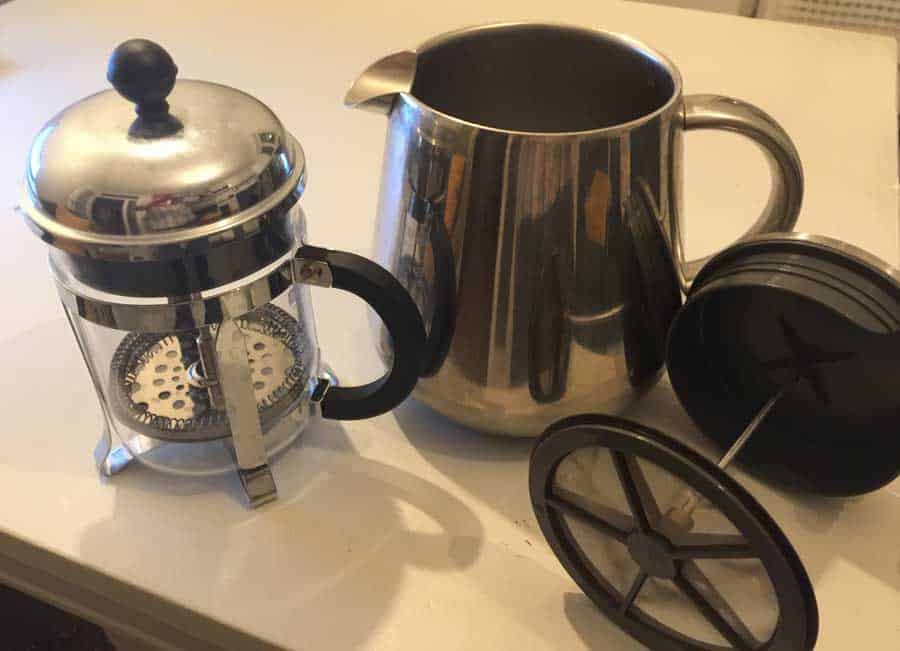
It’s great for camping but it’s not easy to add cream!
Knowing my coffee craziness, my friend Barron asked me why he sometimes has difficulty pushing down the plunger on his French press coffee maker. I was glad to help out.
I told him that there are really only three reasons your French press might be hard to push down: You might have a clogged plunger screen, you might be grinding your coffee too fine, or, most likely, you need to brew it the patient way. Let’s look into what each of these means and what you can do to brew the perfect cup of coffee.
A French press or as it is sometimes called, a plunger pot or cafétiere, is a terrific way to brew coffee. There is no paper filter to get between you and total coffee flavor. They have been around since the 1920s and are manufactured by many companies, such as Bialetti or Bodum, and there are plenty of generics on the market. They can even be found at Walmart or Ikea. In most cases, the brewing apparatuses are much the same. However, sometimes things do not go as easily as they should. Here are some steps you can take to improve your brewing experience.
Clean Your Screen
The easiest thing to check and to fix when using a French press coffee maker is a clogged screen. Roasted coffee contains oils and these oils can combine with coffee “fines” and the minerals and chemicals in your water to clog the screen at the bottom of your French press plunger. This may create a barrier that makes depressing your plunger (sometimes called a piston) very difficult. I have even heard of people pushing so hard that the carafe explodes outward, spraying the kitchen and their clothes with nearly boiling water and soggy coffee grounds. If you habitually just “rinse and swish” and have never thoroughly cleaned your French press coffee maker’s screen, now is the time to take care of that.
How To Clean Your French Press
If your French press is the kind that is easily disassembled, you are in luck, because the process will be a bit easier. But even those that do not come apart can benefit from a cleaning. Pro tip: Pay attention as you take things apart so it will be easier for you to put them back together. Each part can be washed with ordinary dish soap and water. For stubborn deposits, I recommend using a dilute vinegar solution; it dissolves almost anything found on your screen. You also might find a scrub brush or toothbrush useful tool for getting into any cracks and crevices. Thoroughly rinse, dry, and reassemble when you are finished.
The Perfect Grind
Because a French press uses a mesh screen and not a paper filter, proper brewing requires a coarser grind. If you are using an all-purpose grind or (shudder) something out of a can, then how about upgrading to your very own grinder (and maybe some better coffee?).
How To Grind
You should grind your coffee more coarsely than what you would find in a can of Maxwell House. A finer grind means more sediment and bitterness in your cup. Too coarse equals ineffective flavor extraction, so do some experimentation to get the perfect balance for your taste buds. It is worth noting that the very small bits of coffee, called “fines,” created during grinding may contribute to the clogging of your screen and you will get more of these if you are using a blade-type grinder. For a more uniform grind, I recommend a burr grinder.
Tim’s Step-by-Step Patient Method for French Press Brewing
While the cleanliness of your press and the grind of your coffee are important, the far more likely cause of your difficulty in pushing down the plunger is because your coffee has not had enough time to brew. I mean, I get it… it’s the morning… you are not fully awake… you aren’t thinking clearly because you haven’t had your morning cup of coffee yet… it’s tough. Trust me. Take your time and in five or ten minutes, you can have a terrific cup of coffee, with no muss, fuss, or physical exertion.
Here’s what you’ll need to brew it the patient way.
- Your clean and reassembled French press pot
- The appropriate amount of ground coffee (according to the Specialty Coffee Association the correct coffee / water ratio is 55 grams of coffee to one liter of water. If you don’t have a scale or can’t be bothered, it works out to roughly two tablespoons of coffee per six-ounce cup)
- The appropriate amount of boiling water
- A Chopstick or another soft stirring implement that will not damage your carafe
How it’s done
The First Pour
Place your coarsely ground coffee in the pot. Make certain you have figured out the proper coffee to water ratio for your pot. Heat your water to 195° F (91° C) to 205° F (96° C). I like to get the kettle to the boil, take it off the heat, and then wait a few seconds before pouring the water onto the coffee. Water boils at 212° F (100° C) at sea level, so this method seems to work out okay
The Second Pour
Wait three minutes, allowing the water absorption and extraction to occur. Bring the water back to a boil while you are waiting so that you end up with hot, not warm, coffee. Fill the pot the rest of the way and stir again with the chopstick. Recover the pot, slightly pushing the grounds just below the surface. Wait one more minute before pushing the plunger down. It should move fairly easily and your coffee is now ready to be enjoyed!
But what about Barron?
I shared this information with him, although probably too loudly – I was on my second beer – and he later told me that this method solved his problem. He and his wife are now enjoying stress-free mornings.
This is a common issue. Both new and old French press owners have found it hard to push down their plungers. A great deal of superficial information on this topic is on the internet but I learned this method long ago and have used it for years. It has never failed me as long as I keep my patience! Congratulations, you are now one of the elite brewers who knows the secret of making a trouble-free, best possible pot and are ready to enjoy an authentic café au lait.

